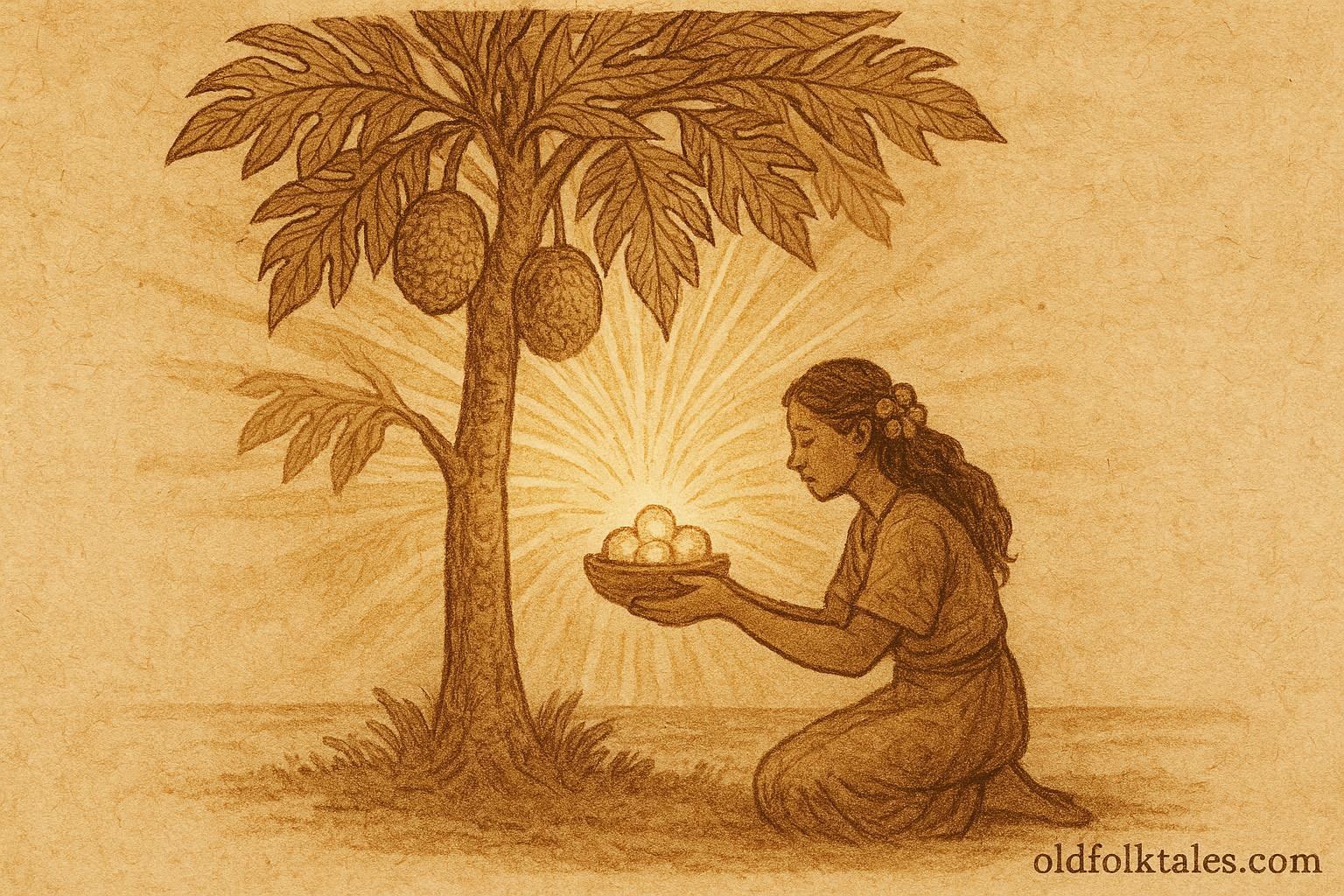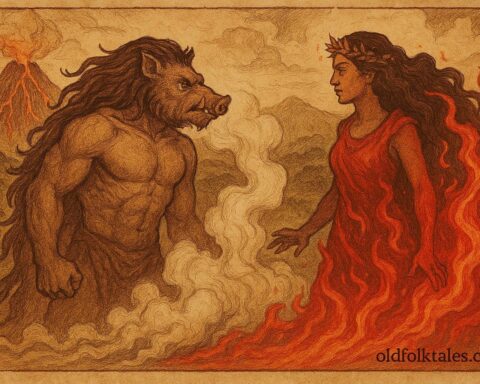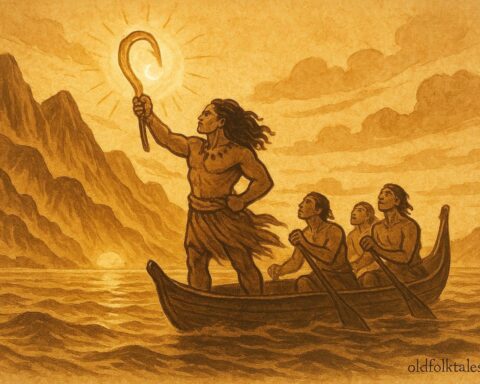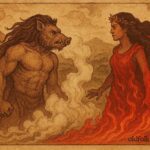Long ago, on the sunlit islands of Tahiti, the land was a paradise overflowing with life. The valleys were green with taro, the rivers glittered like strands of glass, and the hills were crowned with tall, generous breadfruit trees. These trees were the people’s greatest blessing, their round, golden fruits fed every family, rich and poor alike.
It was said that the goddess Haumea, the spirit of abundance, had once walked among the people and gifted them the breadfruit as a symbol of her love. “Honor this tree,” she had told them, “for it holds the life of your island. Share its bounty, and your land will never know hunger.”
Sail through the legends of brave navigators, ocean spirits, and island gods
For many generations, the Tahitians remembered her words. Each harvest, they offered the first ripe breadfruit to the gods, thanking them for the sweetness of the earth. But as time passed and abundance became commonplace, gratitude began to fade.
The People’s Forgetfulness
One year, the breadfruit trees produced more fruit than ever before. The branches bent under the weight of their bounty, and the air was thick with the scent of ripeness. Yet instead of rejoicing with humility, the people became careless.
Some allowed the fruit to rot on the ground; others mocked the old rituals of offering, saying, “Why give thanks when the trees bear fruit without prayer?” Children played games with the fallen breadfruit, tossing them aside, and laughter replaced reverence.
The elders warned that such disrespect would anger the gods, but few listened. In their comfort, the people forgot the sacred balance between giver and gift.
One evening, as the sun dipped below the horizon, the island fell eerily silent. The sea stilled, and the wind that usually danced through the breadfruit leaves ceased to move. Far above, dark clouds gathered, not of rain, but of divine sorrow.
The Goddess Withdraws Her Blessing
That night, Haumea appeared in a dream to the village chief. Her eyes were filled with tears, and her voice trembled like the wind before a storm.
“You have wasted what was sacred,” she said. “You have forgotten the gratitude that keeps the world in balance. Because of your pride, my blessing will be withdrawn.”
When the chief awoke, his heart was heavy with dread. He ran to the grove of breadfruit trees and cried out, but what he saw froze his soul. The trees that had stood lush and green now drooped lifelessly. Their leaves were pale, and their fruit had vanished. The once-lively groves were silent, stripped of life.
Days turned into weeks. The people grew hungry, for the breadfruit had been their main food. The rivers still flowed, and the sea still offered fish, but without the golden fruit, the island felt cursed. The villagers quarreled among themselves, blaming one another. The air was thick with despair.
The Woman’s Offering
In a small hut near the edge of the village lived a woman named Maere, known for her kindness and simplicity. She had lost her husband to the sea and lived alone, gathering fallen coconuts and small fish to survive. Though her life was humble, her heart remained full of gratitude.
One evening, as hunger spread through the island, Maere found her last portion of food, a single coconut and a small handful of cooked taro. Instead of eating, she knelt by her window, gazed at the withered breadfruit tree outside, and whispered,
“Haumea, giver of all things, I thank you still. The earth has fed me all my days, and even now, I am grateful. May your trees live again so that others may eat.”
She placed her small meal beneath the roots of the dying tree as an offering, a gesture of faith and humility.
That night, as she slept, the air grew warm and fragrant once more. The winds returned, carrying the soft whisper of leaves. Maere dreamed of Haumea, radiant and smiling.
“Your heart has remembered what others forgot,” said the goddess. “Through your gratitude, life shall return.”
The Return of the Breadfruit
At dawn, Maere awoke to a sound she had not heard in months, the rustling of full, living branches. She stepped outside and gasped. Her small breadfruit tree was covered in new leaves and glimmering with young green fruit. The miracle spread quickly, one by one, the other trees across the island began to bloom again.
When the villagers saw what had happened, they hurried to Maere’s hut and fell to their knees. The chief declared her the keeper of gratitude and ordered that each family bring offerings to the breadfruit grove once more.
The people prepared a feast to honor Haumea. They roasted the first ripe fruits and shared them among all, giving thanks before eating. From that day forward, they never forgot the lesson of humility.
Even now, Tahitian families tell this story when the first breadfruit of the season ripens. They say that if you listen closely in the hush of dawn, you can still hear Haumea’s voice in the rustle of the leaves, reminding all to give thanks for what the earth provides.
Moral Lesson
The Curse of the Breadfruit Tree teaches that gratitude sustains abundance, while greed and waste destroy it. Nature’s gifts are sacred, and only through humility, respect, and thankfulness can balance be restored.
Knowledge Check (Q&A)
- Who are the main characters in The Curse of the Breadfruit Tree?
The story centers on the goddess Haumea, who blesses the people with breadfruit, and Maere, a humble woman whose gratitude restores the island’s abundance. - What caused the breadfruit trees to wither in the Tahitian folktale?
The people’s wastefulness and ingratitude angered the goddess Haumea, who withdrew her divine blessing. - What moral lesson does this Tahitian legend teach?
It teaches the importance of gratitude, humility, and respect for nature’s gifts to maintain harmony and abundance. - How did Maere help restore the breadfruit trees?
Through her faith and selfless offering of her last meal, she reminded the goddess of humanity’s capacity for gratitude. - What does the breadfruit symbolize in Tahitian mythology?
Breadfruit represents sustenance, divine generosity, and the balance between human respect and nature’s bounty. - How is this story connected to Polynesian culture and agriculture?
It reflects Polynesian beliefs in divine reciprocity, that nature and humans thrive together through respect and thankfulness for the land’s gifts.
Source: Adapted from Tahiti: A Paradise Lost, compiled from oral legends by Henry Adams and Teuira Henry (1928).
Cultural Origin: Tahitian (Polynesian Island Agriculture Myth)












